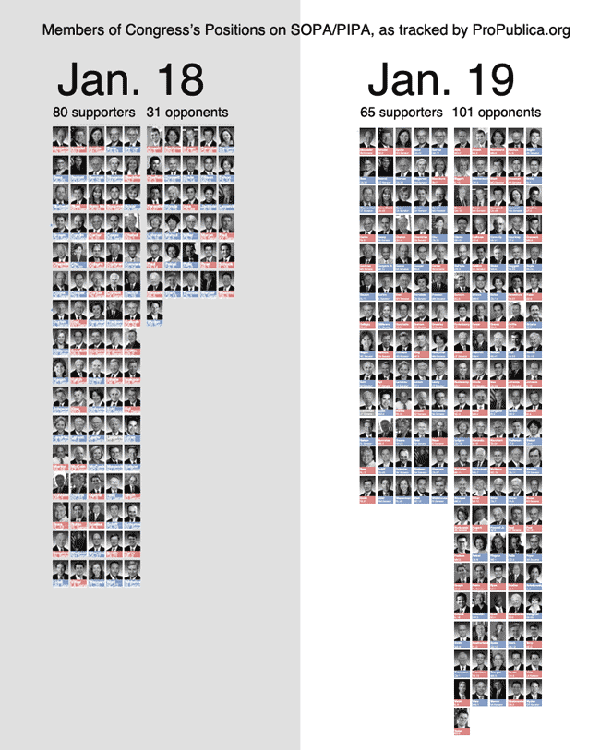
Graphic Sociology opposes PIPA/SOPA
The proposed PIPA and SOPA legislation has been roundly criticized with solid, logical arguments here by danah boyd, here by Tarleton Gillespie who links to 16 other authors who have argued against SOPA/PIPA, and here in a letter Harvard Law Professor Laurence Tribe sent to members of Congress.
As someone who is a passionate scholar of collaboration (both in its cooperative and competitive forms), I worry about the legal and economic repercussions of SOPA/PIPA that have been brought up by the authors mentioned above as well as the negative impact the threat of discretionary censorship would have on the kinds of sharing and borrowing that have made the internet and digital files such a rich source of remixing, incremental improving, and all around innovation. There is no way I could put a dollar figure or other empirical metric on what might happen to remix culture (what the cool kids call it) or innovation (what the business schools call it) under a legal regime in which just about anyone can censor just about anyone else. I can say that the internet as we know it would cease to exist. I post things here on Graphic Sociology that I have designed and created without even mentioning Creative Commons or standard copyright or anything else. If people take my work and get something out of it, that’s fantastic. I don’t even care if they give me credit, though many creative people do, and for good reason. I’m afraid if PIPA and SOPA were to pass, fewer people would re-mix my work and that’s the best kind of use, as far as I am concerned. Reposting is fine, remixing is divine.
I also post the work of others and critique them as an academic, something that is legal under the fair use doctrine. I’m not sure how SOPA and PIPA would mesh with the particular provision of the fair use doctrine that I am exercising. Presumably, they can co-exist, but I certainly don’t have the resources to hire a lawyer and defend myself against anyone who might claim that I’m violating SOPA/PIPA. And as just one of a family of bloggers, any infringement claim against any blog post on the society pages could darken the entire site. So if someone got upset with me, that would mean lights out for Sociological Images, Thick Culture, and all the rest of the blogs here.
The rest of this post is written by guest blogger Alec Campbell of Reed College in Oregon.
Guest post by Alec Campbell, Reed College
What works
This graphic clearly shows that something caused a change between January 18 and January 19. That something was almost certainly the focused attention on SOPA and PIPA resulting from shutdowns, blackouts and other actions taken or led by a number of popular Internet sites (wikipdedia, reddit, the Social Media Collective, and even here at thesocietypages there was a blackout of sorts).
What needs work
The most important flaw in this graph is that it excludes members of congress who are undecided or whose opinions are unknown. Looking at the graph it appears that the distribution of opinion moves from 72% in favor before the Internet shut down to 39% in favor after. In reality the distribution is 15% in favor, 6% opposed and 79% unknown/undecided before the shutdown and 12% in favor, 19% opposed and 69% unknown /undecided after the shutdown. The two graphs aren’t comparable because they don’t include the same total number of observations. When comparing populations of different sizes one has to compare percentages which this graphic does not do.
In fairness, the article accompanying this graphic has links to much more detailed data on SOPA
and PIPA
that does include a full accounting of all members of congress. However, those data don’t allow for comparison over time, which is the central point of this graphic.
What I can’t figure out
It’s clear that there are fewer supporters on January 19 but it isn’t clear if the people who no longer support PIPA/SOPA now oppose it or if they are now undecided. Did the Internet action make converts or agnostics? Arstechnica is keeping a running tally of Senators who are now opposing PIPA, including many of the former co-sponsors of the bill.
The graphic could have used arrows to show movement from one of the three camps (supporters, opposers, undecideds) to help illustrate where the movement happened.
Why it Matters
None of this matters much if our interest is in the fate of SOPA/PIPA. It matters a great deal if we are interested in the power of Internet protest. This graphic is about the power of protest because the prominently displayed time dimension is only relevant to this issue. This graphic overstates the power of Internet protests by omitting the unknown/undecided category making it appear that people changed their minds overnight. Clearly, some did. The number of supporters dropped in absolute terms. However, the larger effect is in convincing people to publicly state their opinion or to finally make up their minds. It is entirely possible that the major effect of the Internet protest was to get congresspersons that were leaning towards opposition to publicly state their opposition and force some supporters to claim an undecided status. That is certainly something but it isn’t the same thing as changing supporters into opponents, which is what the graphic implies.
References
propublic.org following House support of SOPA
propublic.org following Senators support of PIPA
Lee, Timothy. (19 January 2012) PIPA support collapses, with 13 new Senators opposed. [blog post] arstechnica

Comments 1
El paisaje envanecido de las nueva generación de la ciberguerra. | milinviernos — January 22, 2012
[...] Tomado de: Graphic Sociology. [...]